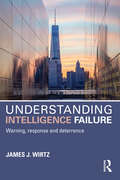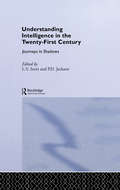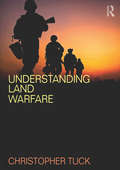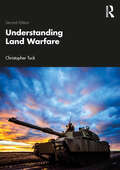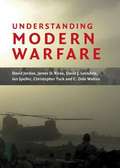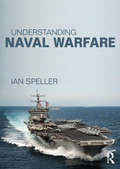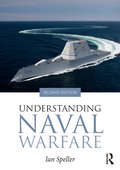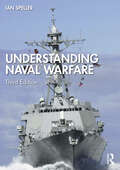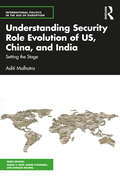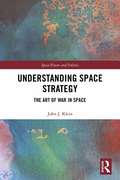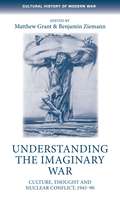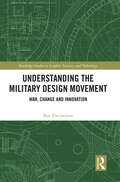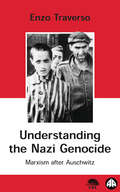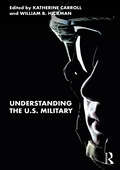- Table View
- List View
Understanding Intelligence Failure: Warning, Response and Deterrence (Studies in Intelligence)
by James J. WirtzThis collection, comprising key works by James J. Wirtz, explains how different threat perceptions can lead to strategic surprise attack, intelligence failure and the failure of deterrence. This volume adopts a strategist’s view of the issue of surprise and intelligence failure by placing these phenomena in the context of conflict between strong and weak actors in world affairs. A two-level theory explains the incentives and perceptions of both parties when significant imbalances of military power exist between potential combatants, and how this situation sets the stage for strategic surprise and intelligence failure to occur. The volume illustrates this theory by applying it to the Kargil Crisis, attacks launched by non-state actors, and by offering a comparison of Pearl Harbor and the September 11, 2001 attacks. It explores the phenomenon of deterrence failure; specifically, how weaker parties in an enduring or nascent conflict come to believe that deterrent threats posed by militarily stronger antagonists will be undermined by various constraints, increasing the attractiveness of utilising surprise attack to achieve their objectives. This work also offers strategies that could mitigate the occurrence of intelligence failure, strategic surprise and the failure of deterrence. This book will be of much interest to students of intelligence studies, strategic studies, security studies and IR in general.
Understanding Intelligence in the Twenty-First Century: Journeys in Shadows
by Peter Jackson L. V. ScottOver the past few decades, international history and security have been significantly influenced by greater understanding of the role of intelligence in national security and foreign policy-making. In Britain, much of the work has developed in the subdiscipline of international history with its methodological predisposition towards archive-ba
Understanding Intelligence in the Twenty-First Century: Journeys in Shadows (Studies In Intelligence Ser.)
by L. V. Scott P. D. JacksonOver the past few decades, international history and security have been significantly influenced by greater understanding of the role of intelligence in national security and foreign policy-making. In Britain, much of the work has developed in the subdiscipline of international history with its methodological predisposition towards archive-ba
Understanding Land Warfare
by Christopher TuckUnderstanding Land Warfare provides a thorough grounding in the vocabulary, concepts, issues and debates associated with modern land warfare. The book is a thematic, debate-driven analysis of what makes land warfare unique; how it interacts with the other environments; the key concepts that shape how it is executed; the trade-offs associated with its prosecution; and the controversies that continue to surround its focus and development. Understanding Land Warfare contains several key themes: the difficulty of conducting land warfare the interplay between change and continuity the growing importance of co-operation the variety of ways in which land warfare is fought; the competing theoretical debates; the tensions and trade-offs. This book will be essential reading for military personnel studying on cadet, intermediate and staff courses. In addition, it will also be of use to undergraduate and postgraduate students of military history, war studies and strategic studies.
Understanding Land Warfare
by Christopher TuckUnderstanding Land Warfare provides a thorough grounding in the vocabulary, concepts, issues and debates associated with modern land warfare. The book is a thematic, debate-driven analysis of what makes land warfare unique; how it interacts with the other environments; the key concepts that shape how it is executed; the trade-offs associated with its prosecution; and the controversies that continue to surround its focus and development. Understanding Land Warfare contains several key themes: the difficulty of conducting land warfare the interplay between change and continuity the growing importance of co-operation the variety of ways in which land warfare is fought; the competing theoretical debates; the tensions and trade-offs. This book will be essential reading for military personnel studying on cadet, intermediate and staff courses. In addition, it will also be of use to undergraduate and postgraduate students of military history, war studies and strategic studies.
Understanding Land Warfare
by Christopher TuckThis textbook provides a thorough grounding in the vocabulary, concepts, issues and debates associated with modern land warfare. The second edition has been updated and revised, and includes new chapters on non-western perspectives and hybrid warfare. Drawing on a range of case studies spanning the First World War through to contemporary conflicts in Syria, Ukraine, and Nagorno-Karabakh, the book explores what is unique about the land domain and how this has shaped the theory and practice of military operations conducted upon it. It also looks at land warfare across the spectrum of its conduct, including conventional campaigning, counterinsurgency, and peace support and stabilisation operations. Key themes and debates identified and analysed include: the tensions between change and continuity; the role of technology in land warfare; the relevance of culture and context; the difficulties in translating theory into effective military practice; in-depth discussions on issues of immediate contemporary significance, including hybrid warfare, emerging military technologies, and the military reform processes of the US, Russian, and Chinese land forces. This book will be essential reading for military practitioners and for students of land warfare, military history, war studies and strategic studies.
Understanding Land Warfare
by Christopher TuckThis textbook provides a thorough grounding in the vocabulary, concepts, issues and debates associated with modern land warfare. The second edition has been updated and revised, and includes new chapters on non-western perspectives and hybrid warfare. Drawing on a range of case studies spanning the First World War through to contemporary conflicts in Syria, Ukraine, and Nagorno-Karabakh, the book explores what is unique about the land domain and how this has shaped the theory and practice of military operations conducted upon it. It also looks at land warfare across the spectrum of its conduct, including conventional campaigning, counterinsurgency, and peace support and stabilisation operations. Key themes and debates identified and analysed include: the tensions between change and continuity; the role of technology in land warfare; the relevance of culture and context; the difficulties in translating theory into effective military practice; in-depth discussions on issues of immediate contemporary significance, including hybrid warfare, emerging military technologies, and the military reform processes of the US, Russian, and Chinese land forces. This book will be essential reading for military practitioners and for students of land warfare, military history, war studies and strategic studies.
Understanding Modern Warfare (PDF)
by David Jordan James D. Kiras David J. Lonsdale Ian Speller Christopher Tuck C. Dale WaltonA major study of the theory and practice of warfare in the twentieth and twenty-first centuries. Using relevant examples from recent history, this book provides a complete introduction to the issues, ideas, concepts, context and vocabulary of modern warfare. The expert team of authors explore the conduct of war across land, sea, air and space in addition to addressing key issues relating to contemporary strategy, weapons of mass destruction and irregular warfare, including insurgency, terrorism and civil war. They provide an incisive and structured grounding in military theory and argue for the importance of understanding warfare within the joint (inter-service) context and as an evolutionary rather than a revolutionary phenomenon. By providing the tools required to truly understand contemporary military doctrine this accessible survey will be an invaluable resource for any student of military history or international relations as well as for military professionals. 9780521700382
Understanding Naval Warfare
by Ian SpellerThis new textbook offers the reader an accessible introduction to the study of modern naval warfare, providing a thorough grounding in the vocabulary, concepts, issues, debates and relevant history. Navies operate in an environment that most people do not understand and that many avoid. They are equipped with a bewildering range of ships, craft and other vessels and types of equipment whose purpose is often unclear. Writings on naval warfare are usually replete with references to obscure concepts explained in arcane language that can serve as an effective barrier to understanding. It is the objective of this book to cut through the obscure and the arcane to offer a clear, coherent and accessible guide to the key features of naval warfare that will equip the reader with the knowledge and understanding necessary for a sophisticated engagement with the subject. Understanding Naval Warfare is divided into two key parts. The first focuses on concepts of naval warfare and introduces readers to the key concepts and ideas associated with the theory and practice of naval operations. The second part focuses on the conduct of war at sea, and also on peacetime roles for contemporary navies. This section concludes with a chapter that looks ahead to the likely future of naval warfare, assessing whether navies are likely to be more or less useful than in the past. This textbook will be essential reading for students of naval warfare, seapower and maritime security, and highly recommended for students of military history, strategic studies and security studies in general.
Understanding Naval Warfare
by Ian SpellerThis new textbook offers the reader an accessible introduction to the study of modern naval warfare, providing a thorough grounding in the vocabulary, concepts, issues, debates and relevant history. Navies operate in an environment that most people do not understand and that many avoid. They are equipped with a bewildering range of ships, craft and other vessels and types of equipment whose purpose is often unclear. Writings on naval warfare are usually replete with references to obscure concepts explained in arcane language that can serve as an effective barrier to understanding. It is the objective of this book to cut through the obscure and the arcane to offer a clear, coherent and accessible guide to the key features of naval warfare that will equip the reader with the knowledge and understanding necessary for a sophisticated engagement with the subject. Understanding Naval Warfare is divided into two key parts. The first focuses on concepts of naval warfare and introduces readers to the key concepts and ideas associated with the theory and practice of naval operations. The second part focuses on the conduct of war at sea, and also on peacetime roles for contemporary navies. This section concludes with a chapter that looks ahead to the likely future of naval warfare, assessing whether navies are likely to be more or less useful than in the past. This textbook will be essential reading for students of naval warfare, seapower and maritime security, and highly recommended for students of military history, strategic studies and security studies in general.
Understanding Naval Warfare
by Ian SpellerThis new and updated edition of Understanding Naval Warfare offers the reader an accessible introduction to the study of modern naval warfare, providing a thorough grounding in the vocabulary, concepts, issues, and debates, set within the context of relevant history. Navies operate in an environment that most people do not understand and that many avoid. They are equipped with a bewildering range of ships, craft and other vessels and types of equipment, the purpose of which is often unclear. Writings on naval warfare are usually replete with references to esoteric concepts explained in specialist language than can serve as a barrier to understanding. The objective of this book, therefore, is to cut through the obscure and the arcane to offer a clear, coherent and accessible guide to the key features of naval warfare which will equip the reader with the knowledge and understanding necessary for a sophisticated engagement with the subject. This second edition is divided into two key parts. The first focuses on concepts of naval warfare and introduces readers to the ideas associated with the theory and practice of naval operations. It also includes a new chapter in which the history of the last century of naval warfare is explored in order to illustrate the key concepts. The second part focuses on the conduct of war at sea and on peacetime roles for contemporary navies. This latter section concludes with a chapter that looks ahead to the likely future of naval warfare. This textbook will be essential reading for students of naval warfare, sea power and maritime security, and highly recommended for those studying military history, strategic studies and security studies in general.
Understanding Naval Warfare
by Ian SpellerThis new and updated edition of Understanding Naval Warfare offers the reader an accessible introduction to the study of modern naval warfare, providing a thorough grounding in the vocabulary, concepts, issues, and debates, set within the context of relevant history. Navies operate in an environment that most people do not understand and that many avoid. They are equipped with a bewildering range of ships, craft and other vessels and types of equipment, the purpose of which is often unclear. Writings on naval warfare are usually replete with references to esoteric concepts explained in specialist language than can serve as a barrier to understanding. The objective of this book, therefore, is to cut through the obscure and the arcane to offer a clear, coherent and accessible guide to the key features of naval warfare which will equip the reader with the knowledge and understanding necessary for a sophisticated engagement with the subject. This second edition is divided into two key parts. The first focuses on concepts of naval warfare and introduces readers to the ideas associated with the theory and practice of naval operations. It also includes a new chapter in which the history of the last century of naval warfare is explored in order to illustrate the key concepts. The second part focuses on the conduct of war at sea and on peacetime roles for contemporary navies. This latter section concludes with a chapter that looks ahead to the likely future of naval warfare. This textbook will be essential reading for students of naval warfare, sea power and maritime security, and highly recommended for those studying military history, strategic studies and security studies in general.
Understanding Naval Warfare
by Ian SpellerThis updated new edition of Understanding Naval Warfare offers the reader an accessible introduction to the study of modern naval warfare, providing a thorough grounding in the vocabulary, concepts, issues and debates, set within the context of relevant history. The third edition explains traditional concepts and explores current and emerging ideas concerning the theory and practice of naval warfare, relating these to recent events including Sino-American naval competition and the Russian-Ukraine War. Navies operate in an environment that most people do not understand and that many avoid. They are equipped with a bewildering range of ships, craft and other vessels and types of equipment, the purpose of which is often unclear. Writings on naval warfare are usually replete with references to esoteric concepts explained in specialist language that can serve as a barrier to understanding. This book cuts through the obscure and the arcane to offer a clear, coherent and accessible guide to the key features of naval warfare which will equip the reader with the knowledge and understanding necessary for a sophisticated engagement with the subject. The new edition is divided into two key parts. The first focuses on concepts of naval warfare and introduces readers to the ideas associated with the theory and practice of naval operations and includes a chapter where the history of the last century of naval warfare is explored in order to illustrate the key concepts. The second part focuses on the conduct of war at sea and on peacetime roles for contemporary navies and now includes new material on hybrid warfare and grey zone operations and on joint warfare, multi-domain operations and integrated deterrence within the context of evolving great power rivalry at sea. This textbook will be essential reading for students of naval warfare, sea power and maritime security and is highly recommended for those studying military history, strategic studies and security studies in general.
Understanding Naval Warfare
by Ian SpellerThis updated new edition of Understanding Naval Warfare offers the reader an accessible introduction to the study of modern naval warfare, providing a thorough grounding in the vocabulary, concepts, issues and debates, set within the context of relevant history. The third edition explains traditional concepts and explores current and emerging ideas concerning the theory and practice of naval warfare, relating these to recent events including Sino-American naval competition and the Russian-Ukraine War. Navies operate in an environment that most people do not understand and that many avoid. They are equipped with a bewildering range of ships, craft and other vessels and types of equipment, the purpose of which is often unclear. Writings on naval warfare are usually replete with references to esoteric concepts explained in specialist language that can serve as a barrier to understanding. This book cuts through the obscure and the arcane to offer a clear, coherent and accessible guide to the key features of naval warfare which will equip the reader with the knowledge and understanding necessary for a sophisticated engagement with the subject. The new edition is divided into two key parts. The first focuses on concepts of naval warfare and introduces readers to the ideas associated with the theory and practice of naval operations and includes a chapter where the history of the last century of naval warfare is explored in order to illustrate the key concepts. The second part focuses on the conduct of war at sea and on peacetime roles for contemporary navies and now includes new material on hybrid warfare and grey zone operations and on joint warfare, multi-domain operations and integrated deterrence within the context of evolving great power rivalry at sea. This textbook will be essential reading for students of naval warfare, sea power and maritime security and is highly recommended for those studying military history, strategic studies and security studies in general.
Understanding Security Role Evolution of US, China, and India: Setting the Stage (International Politics in the Age of Disruption)
by Aditi MalhotraThis book revolves around the altering security roles of three pivotal powers – the US, China, and India. Each of these actors has experienced incremental changes in their external roles and behaviour over the last two decades, which are determined by the range of domestic and international factors. As each country works towards performing its revised security roles, the policymakers are subject to dilemmas and challenges that impact policy implementation and conduct. Using the framework of role theory, the book analyses the role evolution of these countries and elucidates its link with their security policies in the Indo-Pacific and on the global stage. In the process, it also examines the systemic and sub-systemic factors that determine the foreign and security behaviour of these critical Indo-Pacific countries. Accessibly written, this volume will be of great interest to scholars and researchers of international relations, security and intelligence studies, political science, and foreign policy. It will also be of great interest to policymakers, career bureaucrats, security and intelligence practitioners, and professionals working with think tanks and embassies.
Understanding Security Role Evolution of US, China, and India: Setting the Stage (International Politics in the Age of Disruption)
by Aditi MalhotraThis book revolves around the altering security roles of three pivotal powers – the US, China, and India. Each of these actors has experienced incremental changes in their external roles and behaviour over the last two decades, which are determined by the range of domestic and international factors. As each country works towards performing its revised security roles, the policymakers are subject to dilemmas and challenges that impact policy implementation and conduct. Using the framework of role theory, the book analyses the role evolution of these countries and elucidates its link with their security policies in the Indo-Pacific and on the global stage. In the process, it also examines the systemic and sub-systemic factors that determine the foreign and security behaviour of these critical Indo-Pacific countries. Accessibly written, this volume will be of great interest to scholars and researchers of international relations, security and intelligence studies, political science, and foreign policy. It will also be of great interest to policymakers, career bureaucrats, security and intelligence practitioners, and professionals working with think tanks and embassies.
Understanding Space Strategy: The Art of War in Space (Space Power and Politics)
by John J. KleinThis book examines the rise of great power competition in space, including the relevant and practical space strategies for China, Russia, the United States, and other countries. The work discusses the concepts and writings of past strategists, such as Thucydides, Sun Tzu, and Clausewitz, in relation to warfare initiated in or extending into space. This analysis underscores why polities initiate war based upon an assessment of fear, honor, and interest, and explains why this will also be true of war in space. Based upon the timeless strategic writings of the past, the book uncovers the strategy of space warfare, along with the concepts of deterrence, dissuasion, and the inherent right of self-defense, and outlines strategies for great, medium, and emerging space powers. Additionally, it highlights changes needed to space strategy based upon the Law of Armed Conflict, norms of behavior, and Rules of Engagement. The work also examines advancements and emerging trends in the commercial space sector, as well as what these changes mean for the implementation of a practical space strategy. Given the rise of great power competition in space, this work presents a space strategy based upon historical experience. This book will be of much interest to students of space policy, strategic studies, and International Relations.
Understanding Space Strategy: The Art of War in Space (Space Power and Politics)
by John J. KleinThis book examines the rise of great power competition in space, including the relevant and practical space strategies for China, Russia, the United States, and other countries. The work discusses the concepts and writings of past strategists, such as Thucydides, Sun Tzu, and Clausewitz, in relation to warfare initiated in or extending into space. This analysis underscores why polities initiate war based upon an assessment of fear, honor, and interest, and explains why this will also be true of war in space. Based upon the timeless strategic writings of the past, the book uncovers the strategy of space warfare, along with the concepts of deterrence, dissuasion, and the inherent right of self-defense, and outlines strategies for great, medium, and emerging space powers. Additionally, it highlights changes needed to space strategy based upon the Law of Armed Conflict, norms of behavior, and Rules of Engagement. The work also examines advancements and emerging trends in the commercial space sector, as well as what these changes mean for the implementation of a practical space strategy. Given the rise of great power competition in space, this work presents a space strategy based upon historical experience. This book will be of much interest to students of space policy, strategic studies, and International Relations.
Understanding the imaginary war: Culture, thought and nuclear conflict, 1945–90 (PDF) (Cultural History of Modern War)
by Benjamin Ziemann Matthew GrantThis collection offers a fresh interpretation of the Cold War as an imaginary war, a conflict that had imaginations of nuclear devastation as one of its main battlegrounds. The book includes survey chapters and case studies on Western Europe, the USSR, Japan and the USA. Looking at various strands of intellectual debate and at different media, from documentary film to fiction, the chapters demonstrate the difficulties to make the unthinkable and unimaginable - nuclear apocalypse - imaginable. The book will be required reading for everyone who wants to understand the cultural dynamics of the Cold War through the angle of its core ingredient, nuclear weapons.
Understanding the imaginary war: Culture, thought and nuclear conflict, 1945–90 (Cultural History of Modern War)
by Benjamin Ziemann Matthew GrantThis collection offers a fresh interpretation of the Cold War as an imaginary war, a conflict that had imaginations of nuclear devastation as one of its main battlegrounds. The book includes survey chapters and case studies on Western Europe, the USSR, Japan and the USA. Looking at various strands of intellectual debate and at different media, from documentary film to fiction, the chapters demonstrate the difficulties to make the unthinkable and unimaginable - nuclear apocalypse - imaginable. The book will be required reading for everyone who wants to understand the cultural dynamics of the Cold War through the angle of its core ingredient, nuclear weapons.
Understanding the Military Design Movement: War, Change and Innovation (Routledge Studies in Conflict, Security and Technology)
by Ben ZweibelsonThis book explains the history and development of the military design movement, featuring case studies from key modern militaries. Written by a practitioner, the work shows how modern militaries think and arrange actions in time and space for security affairs, and why designers are disrupting, challenging, and reconceptualizing everything previously upheld as sacred on the battlefield. It is the first book to thoroughly explain what military design is, where it came from, and how it works at deep, philosophically grounded levels, and why it is potentially the most controversial development in generations of war fighters. The work explains the tangled origins of commercial design and that of designing modern warfare, the rise of various design movements, and how today’s military forces largely hold to a Newtonian stylization built upon mimicry of natural science infused with earlier medieval and religious inspirations. Why does our species conceptualize war as such, and how do military institutions erect barriers that become so powerful that efforts to design further innovation require entirely novel constructs outside the orthodoxy? The book explains design stories from the Israel Defense Force, the US Army, the US Marine Corps, the Canadian Armed Forces, and the Australian Defence Force for the first time, and includes the theory, doctrine, organizational culture, and key actors involved. Ultimately, this book is about how small communities of practice are challenging the foundations of modern defence thinking. This book will be of much interest to students of military and strategic studies, defence studies, and security studies, as well as design educators and military professionals.
Understanding the Military Design Movement: War, Change and Innovation (Routledge Studies in Conflict, Security and Technology)
by Ben ZweibelsonThis book explains the history and development of the military design movement, featuring case studies from key modern militaries. Written by a practitioner, the work shows how modern militaries think and arrange actions in time and space for security affairs, and why designers are disrupting, challenging, and reconceptualizing everything previously upheld as sacred on the battlefield. It is the first book to thoroughly explain what military design is, where it came from, and how it works at deep, philosophically grounded levels, and why it is potentially the most controversial development in generations of war fighters. The work explains the tangled origins of commercial design and that of designing modern warfare, the rise of various design movements, and how today’s military forces largely hold to a Newtonian stylization built upon mimicry of natural science infused with earlier medieval and religious inspirations. Why does our species conceptualize war as such, and how do military institutions erect barriers that become so powerful that efforts to design further innovation require entirely novel constructs outside the orthodoxy? The book explains design stories from the Israel Defense Force, the US Army, the US Marine Corps, the Canadian Armed Forces, and the Australian Defence Force for the first time, and includes the theory, doctrine, organizational culture, and key actors involved. Ultimately, this book is about how small communities of practice are challenging the foundations of modern defence thinking. This book will be of much interest to students of military and strategic studies, defence studies, and security studies, as well as design educators and military professionals.
Understanding the Nazi Genocide: Marxism After Auschwitz (IIRE (International Institute for Research and Education))
by Enzo Traverso'...this is a genuinely original contribution to our understanding. Students of the Holocaust sometimes worry that too much analysis may immunise us against its unbelievable horror. Traverso avoids that risk with great sensitivity and imagination.' Socialist Review In Understanding the Nazi Genocide Enzo Traverso sustains a dialogue with writings on the Shoah from Hannah Arendt to Daniel Goldhagen by drawing on the critical and heretical Marxism of Walter Benjamin and the Frankfurt School, which grasped late capitalism’s pent-up capacity for destructive upheavals exacerbated by bureaucratic organisation and advanced technology.After Auschwitz, Hiroshima and the gulag, the old warning slogan - socialism or barbarism - formulated by European Marxists at the beginning of twentieth century needs to be seriously ‘revised’. The choice we face today is no longer between the progress of civilisation and a fall into ancient savagery, but between socialism conceived as a new civilisation and the destruction of humankind. For Traverso the Warsaw Ghetto uprising is an image of what should impel us to rebel: not a sense of inevitable victory, but an ethical imperative.
Understanding the U.S. Military
by Katherine Carroll William B. HickmanThis book offers an accessible introduction to the U.S. military as an institution and provides insights into the military’s structure and norms. Designed for undergraduate students, the book offers an interdisciplinary overview of America’s armed forces through three critical lenses. First, it introduces the military’s constitutional and historical context. Second, it presents concise factual information chosen for its relevance to the military’s structures, procedures, norms, and varied activities. Finally, it intersperses these facts with debates, theories, and questions to spark student interest, class discussion, and further research. The text is written for the beginner but covers complex topics such as force structure and the defense budget. With contributions informed by both scholarly approaches and long military careers, the book will prepare students for further studies in international relations, civil-military relations, or U.S. foreign policy. It also encourages critical thinking, elucidating an institution that undergraduates and other civilians too often perceive as both baffling and above reproach. This book will be of much interest to students of the U.S. military, civil-military relations, U.S. politics, and public policy.
Understanding the U.S. Military
by Katherine Carroll William B. HickmanThis book offers an accessible introduction to the U.S. military as an institution and provides insights into the military’s structure and norms. Designed for undergraduate students, the book offers an interdisciplinary overview of America’s armed forces through three critical lenses. First, it introduces the military’s constitutional and historical context. Second, it presents concise factual information chosen for its relevance to the military’s structures, procedures, norms, and varied activities. Finally, it intersperses these facts with debates, theories, and questions to spark student interest, class discussion, and further research. The text is written for the beginner but covers complex topics such as force structure and the defense budget. With contributions informed by both scholarly approaches and long military careers, the book will prepare students for further studies in international relations, civil-military relations, or U.S. foreign policy. It also encourages critical thinking, elucidating an institution that undergraduates and other civilians too often perceive as both baffling and above reproach. This book will be of much interest to students of the U.S. military, civil-military relations, U.S. politics, and public policy.
